If your business is in any way connected to information technology and software (and you probably wouldn’t be here reading this if it weren’t) you must have heard of massive layoffs in tech companies in 2022 and 2023. You must have also heard that, contrary to the fact that layoffs took place, there’s actually a shortage of tech talent on the market.
One of the solutions for the latter is IT staff augmentation.
Mind Studios provides IT personnel augmentation services alongside other cooperation models. We’ve worked as outstaffers on multiple projects, among which industry leader in meditation apps Asana Rebel and a revolutionary supply chain solution Lumachain. Thus, we feel well-equipped to shine some light on what an augmented workforce can bring to the business table, which is why this article was born.
IT staff augmentation is a cooperation model that entails hiring extra staff from outstaffing agencies to fill in temporary positions in their IT departments. It’s a model beneficial to business owners as it allows them to access a bigger pool of talent, often globally, while saving on a certain portion of costs. But let’s do it all in proper order.
5 main benefits of IT staff augmentation services
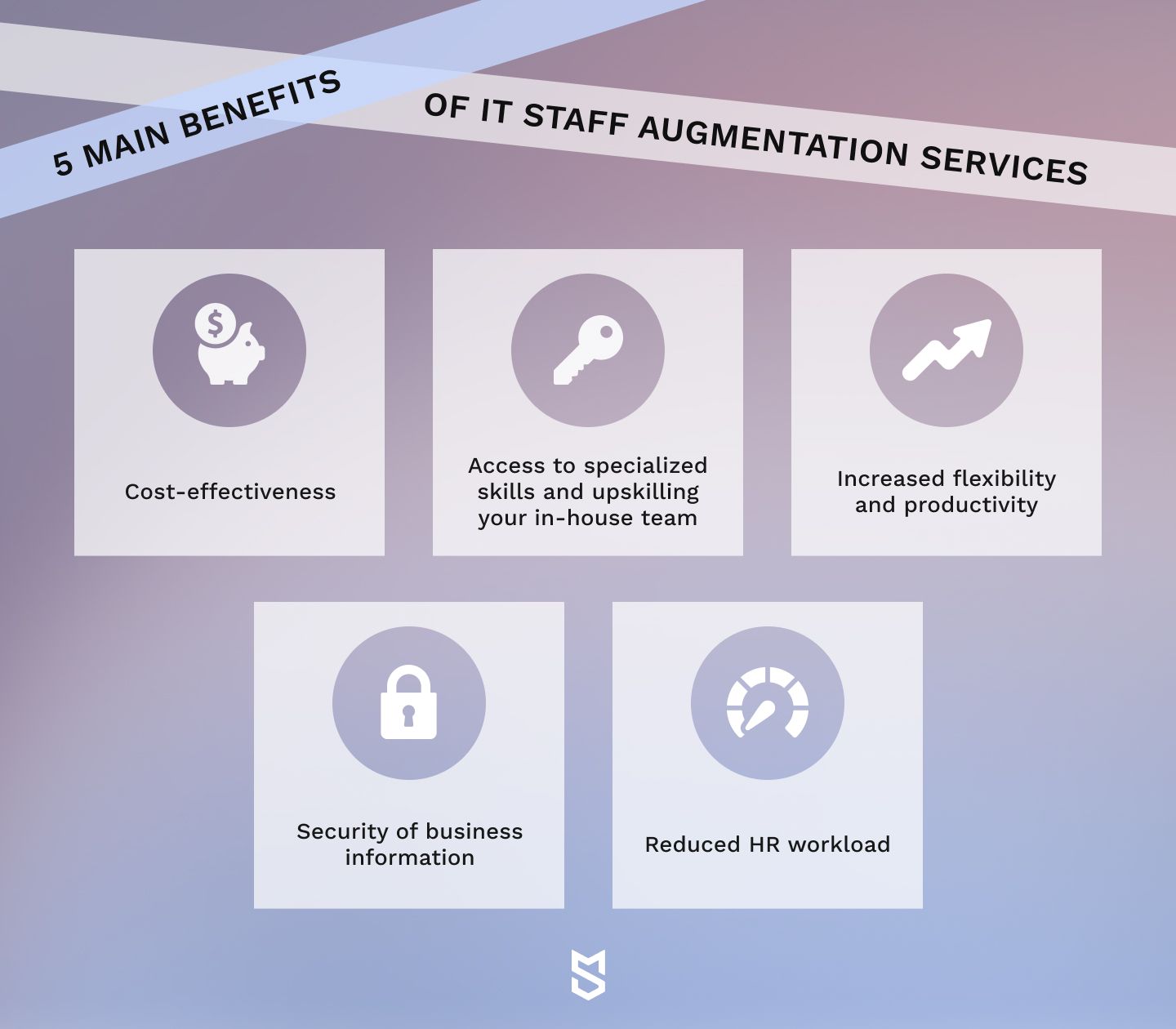
When software is an integral part of your business, it’s sensible and logical to have an in-house team of developers, right? Many mid-size and some small companies have their own IT departments. However, it’s not unusual for such departments to consist of only one person per specialization or, sometimes, a couple multi-taskers — to save on money.
Even if your in-house team is chuck-full of geniuses, you’ve probably hit a wall or two, needing more people or specific skills to deliver your product on time and capture the audience. Hiring more people in-house is the go-to solution, but the process is:
- expensive (the average hiring cost in the US is $4,000 per employee)
- long (it takes about 24 days to find a suitable employee for US-based companies)
- disruptive for the existing team (onboarding new employees takes time off working on the product)
That’s where IT team augmentation can be of help. Here are some of the prominent IT staff augmentation benefits.
1. Cost-effectiveness
A big chunk of spending for an in-house team is the spending that’s not salaries: taxes, employee benefits, equipment, work space, utilities, etc. When you augment your IT department with external workforce, you save money on these extras.
Temporary employees tend to have their own equipment, they often work remotely, and they aren’t granted traditional benefits like tax compensation or paid sick leaves and vacations.
2. Access to specialized skills and upskilling your in-house team
IT contract staffing these days is mostly done with remote teams, meaning the whole planet is your talent pool. You can choose employees with more freedom and, therefore, you can focus more on specific skill sets or technologies you require. When there’s no skilled Elixir developer in your area, you can hire one from across the globe.
Additionally, the staff augmentation model with the help of an agency makes it easier to hire temporary specialists that will work closely with your existing team. That’s a contrast from hiring freelancers, for example: since freelancers usually juggle multiple projects simultaneously, they tend to prefer tasks not dependent on close interaction with an in-house team.
Close collaboration with external specialists offers your in-house team an opportunity to learn from them.
3. Increased flexibility and productivity
Outstaffed IT specialists are flexible by default: they need to be to operate as temporary additions to any team that needs their skills. And their productivity is usually also high for the simple reason that they’re paid for work completed, and to earn more they need to take on more jobs.
This is true for all kinds of external workforce, be it developers from IT staff augmentation firms or freelancers.
4. Security of business information

Here’s another reason to employ agencies instead of freelancers: established companies have policies in place to protect their clients’ information. They readily sign NDAs and regulate all sides of relationships between their staff and clients hiring them.
Moreover, reputable temporary IT staffing companies set up processes to protect themselves and their clients from accidental leaks and data breaches. While freelancers may also follow proper procedures, your control over them is not as tight, meaning information sharing shall be extremely careful.
5. Reduced HR workload
As we’ve mentioned above, hiring a new employee is both costly and time consuming. This includes looking for in-house staff as well as freelancers: your human resources department will have to expand effort to do that.
On the other side of the scale is the established IT outsourcing and outstaffing companies that already have a pool of talent ready to start working as soon as the agreement is signed. When you have a partner like that, the need to burden your HR department with looking for temporary staffers disappears. In one of our insights, we compared staff augmentation and IT outsourcing, so that you can understand which model is more preferable for you and make the final choice.
The two types of IT staff augmentation
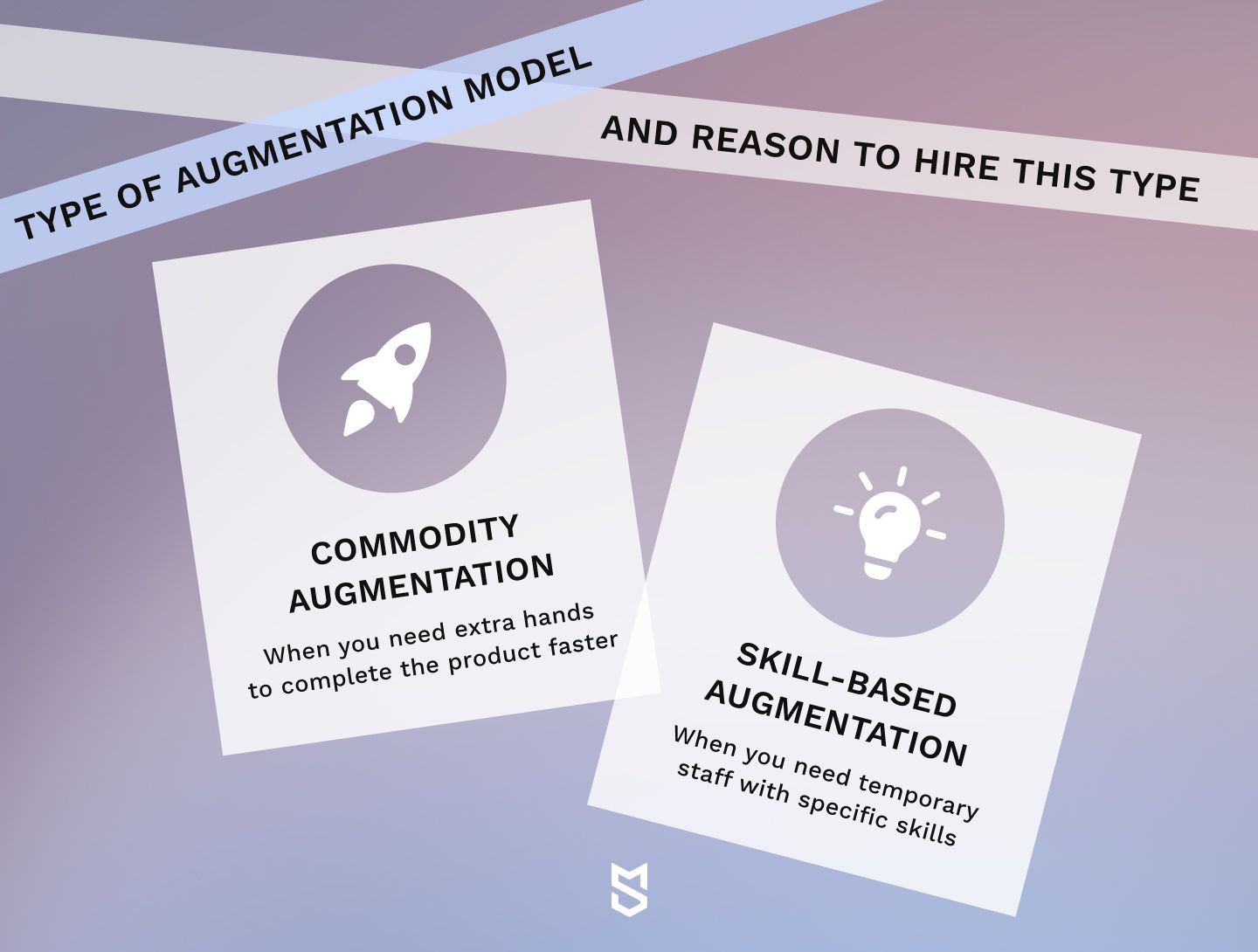
The staff augmentation model is employed by businesses in two main cases:
- When they need extra work force to finish the product faster, or
- When they need temporary staff with specific knowledge or skills to implement certain functionality
Therefore, we tend to divide the IT team augmentation into two categories: commodity and skill-based.
Commodity
This category includes all-purpose IT staff with a wide range of skills applicable in many niches. These people are allocated to projects where there’s need to speed up the development or help with tasks of lower importance your in-house team would otherwise postpone.
It by no means entails low-skill employees, though, please don’t make this mistake. The key to being a good commodity staff extra is being skilled with what one does, as low skills means slower work and more mistakes.
Skill-based
The second category of staffing solutions for IT is skill-based. These are specialists that have mastered specific technologies or can build certain high-level features for software. For example, the rise of AI in the latest years gave rise to high demand for developers well-versed in technologies like Google ML Kit and TensorFlow’s Keras.
At Mind Studios, we have accomplished professionals of both categories: we have experiences developers with a wide range of skills for commodity staff augmentation (backend, front-end, Android & iOS developers, designers, QAs, and BAs) and staff with specialized knowledge like machine learning, high-end security in software, and more.
IT Staff Augmentation vs. Outsourcing: Which Is Right for Your Business?
First things first, let us define the two terms.
The simplest definition can be found on Wikipedia:
| Outsourcing is an agreement in which one company hires another company to be responsible for a planned or existing activity which otherwise is or could be carried out internally, i.e. in-house, and sometimes involves transferring employees and assets from one firm to another. | Staff augmentation is an outsourcing strategy that is used to staff a project and respond to the business objectives. The technique consists of evaluating the existing staff and then determining which additional skills are required. |
As you can see, staff augmentation is a sub-type of outsourcing. However, as the saying goes, the devil is in the details.
In the IT industry, outsourcing usually means you hire a remote team and entrust them with developing your product. You will have negotiable control over the team, set software requirements and deadlines. The team will most likely discuss everything important with you but, in a nutshell, they’re just a third party vendor.
In contrast, IT staff augmentation is when you have an in-house development team working on the product and you’re lacking some specialists so you hire them from a third party vendor. These specialists may or may not work remotely (though the remote scheme has grown in popularity greatly in recent years) but they will closely collaborate with your in-house team where it matters.
Not all outsourcing companies provide staff augmentation services, and there are companies that only do staff augmentation, not full-scale outsourcing. Mind Studios offers both collaboration options, though. And to help you understand whether you need IT staff augmentation or software outsourcing, we will compare the two below.
## IT staff augmentation vs. software outsourcing: Flexibility
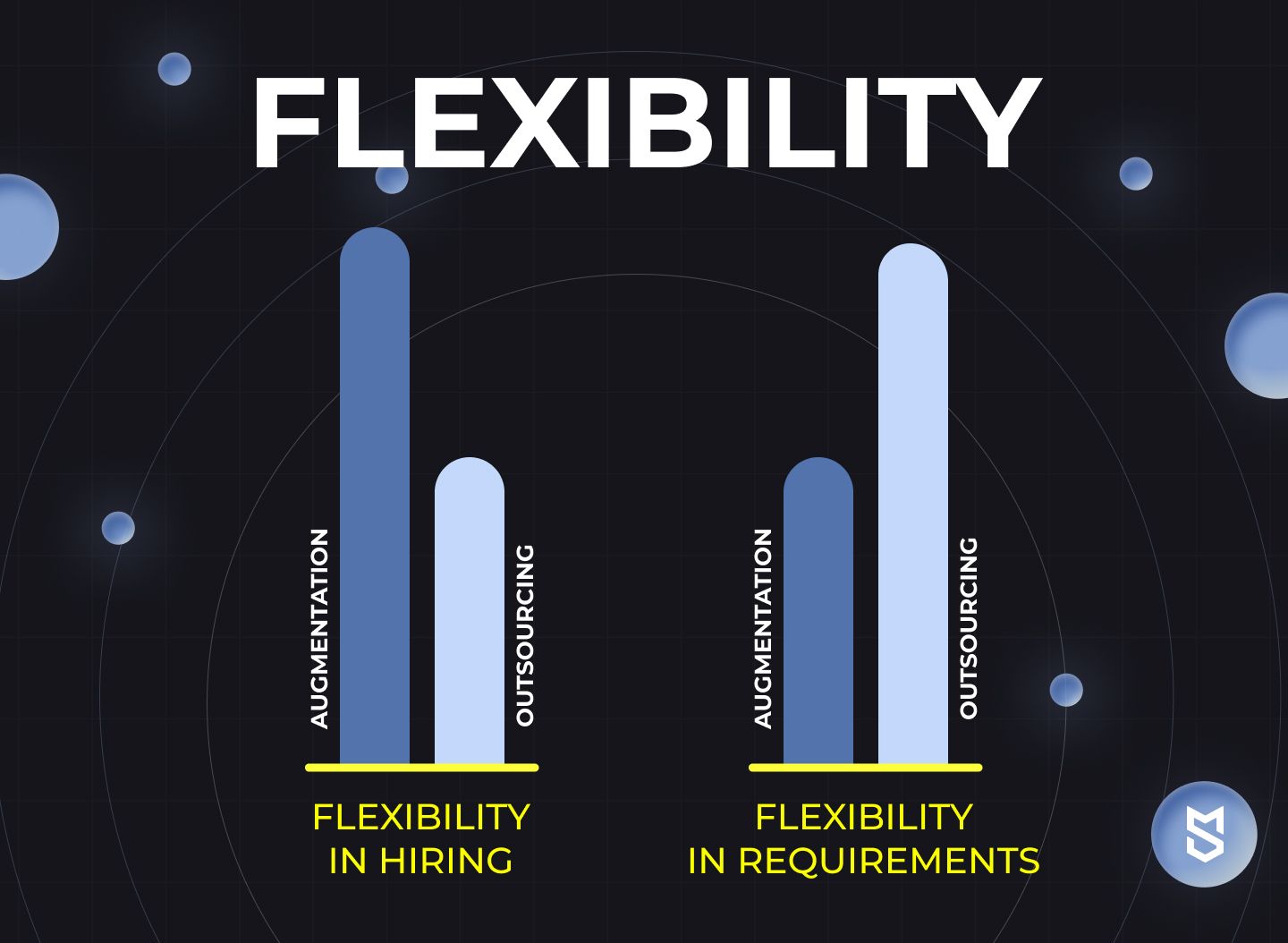
Outsourcing and staff augmentation are both models with a high degree of flexibility, that’s one of the main benefits of outsourcing as a concept. This is especially true if you consider hiring remote temporary staff without limiting yourself by borders or continents (i.e. offshore hiring).
Remote outsourcing and staff augmentation both offer you the opportunity to find highly professional employees with necessary skills all over the globe. However, the two cooperation models focus on slightly different things.
IT staff augmentation model offers more flexibility in hiring than outsourcing does, usually. That is because you (or your trusted employee) will be handpicking people for the necessary roles. You will be able — and need — to consider not only their technical skills but also communication skills, work processes they’re used to, and more. At the root, it will be similar to in-house hiring, since the new people will be closely collaborating with your existing team.
In general outsourcing, flexibility is limited to your requirements for the product rather than the team itself. Usually, when you’re partnering with an outsourcing company, the company allocates specialists who:
- fit the requirements for expertise; and
- are free from other projects / have time to take on another project
Since your communication with the team won’t be as close as it is with an in-house IT staff, there’s little need to try and handpick the team. It’s way more sensible to trust the vendor company as they know the synergy among their employees better anyway.
IT staff augmentation vs. software outsourcing: Control
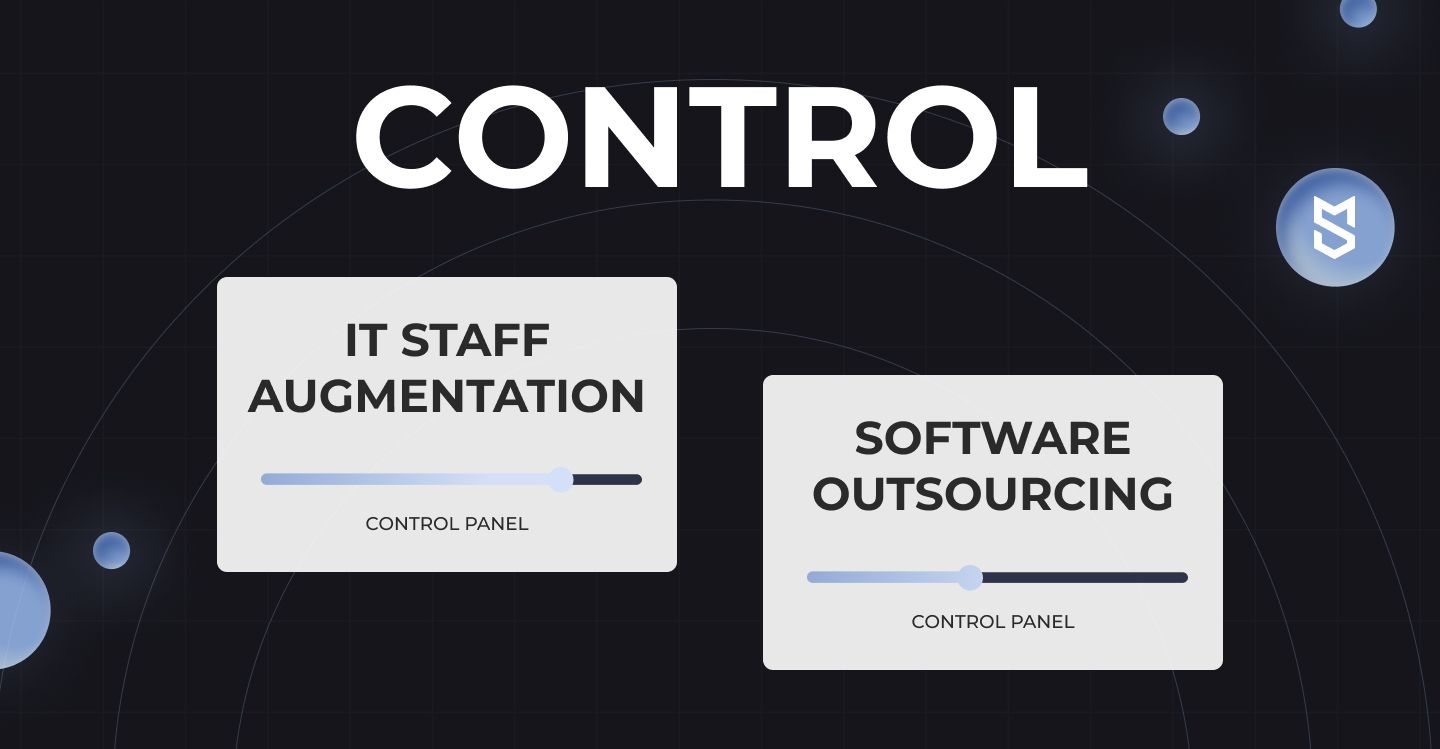
In outsourcing, the control you’ll have over the development is limited by the processes in place in the vendor company. With this cooperation model, you will have an opportunity to:
- set requirements for the product
- decide on acceptance criteria
- choose the frequency and scope of team reports
The internal processes of how the work is conducted will, however, be out of your control, as will be the communication within the team.
In the IT staff augmentation vs software outsourcing stand-off, though, the former offers you more control over hired talent, as they will be, albeit temporarily, your employees and will work in a collaboration with your in-house team. You and your in-house team will be able to closely monitor the work a temp does, as you would with an in-house employee. But you or your in-house tech lead will need to be more involved in project management.
Staff augmentation vs. software outsourcing: Quality and expertise
Even though staff augmentation and outsourcing are two modifications of the same model, they differ quite a bit when it comes to quality of work. That said, it’s not about how one is better than the other.
It all goes back to your (product owner’s) control over the development process.
Being fully in control of handpicking staff for augmentation means you will most likely choose people who will have exactly the expertise and skills you need to enhance your in-house team. Moreover, by closely monitoring the development, you as the product owner will be able to influence the processes as you see fit, making the end product as close to your vision as possible.
Now, with a responsive and experienced outsourcing team, it’s also possible to receive at the end exactly the product you planned. However, this will require more communication and dedication. And one of the reasons business owners choose to outsource their software is that they can entrust the product to professionals and dedicate their own time to other business tasks.
IT staff augmentation vs. software outsourcing: Cost-efficiency
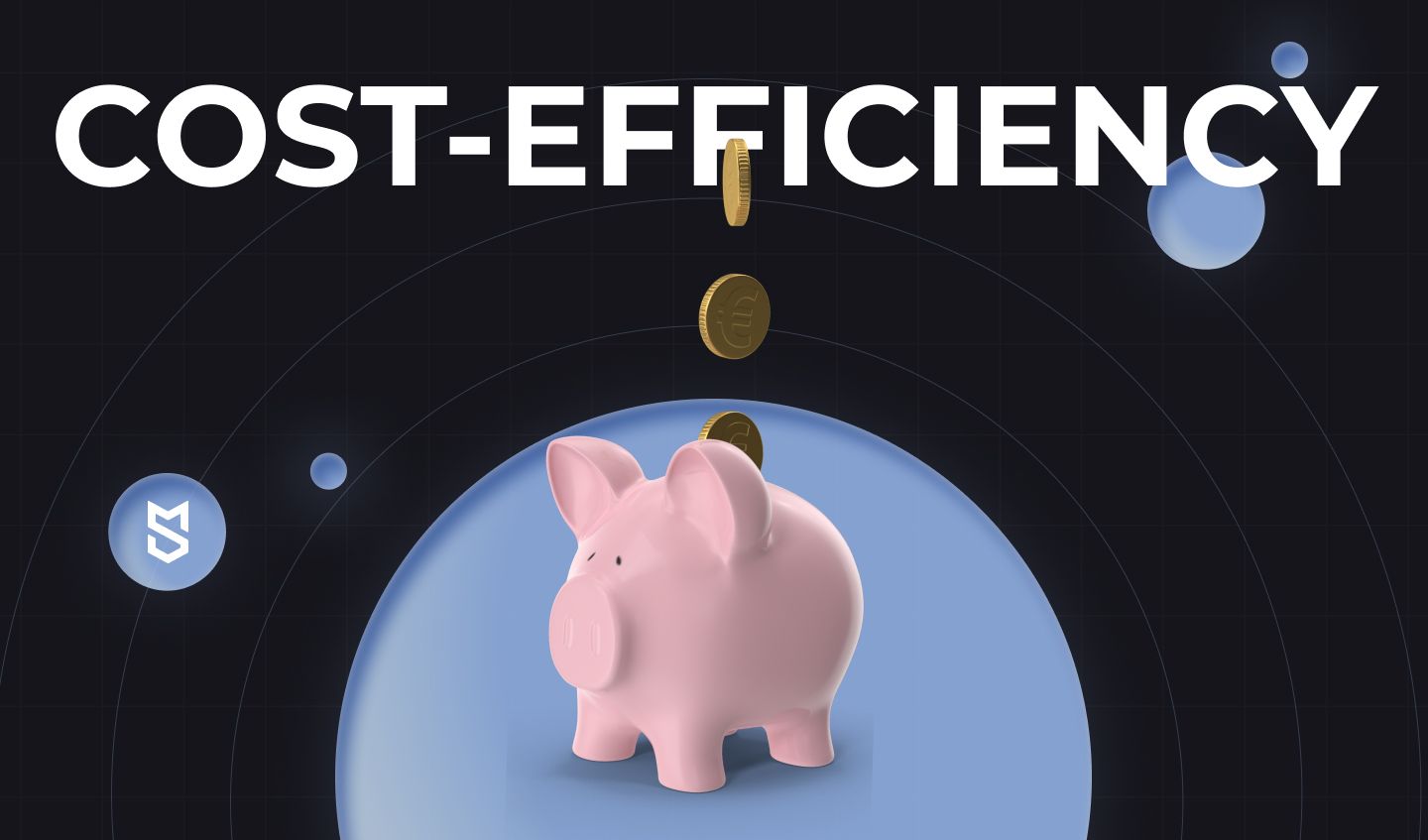
Pinning staff augmentation vs IT outsourcing when it comes to cost-efficiency is, in our experience, an incorrect approach. The reason for that is this: staff augmentation and outsourcing are traditionally used for different situations.
More often than not, outsourcing is used for larger and more complex products. And while different cooperation models exist within outsourcing, one of the most popular ones is the so-called fixed price model.
When we at Mind Studios estimate projects with our clients, we usually provide an end-cost. It’s adjustable to a degree since we work in the Agile development methodology, but with outsourcing, you usually know the amount of investment you’ll need to pour in. This allows to assess your product beforehand and prioritize features to fit your budget.
In IT staff augmentation, you pay for each employee you hire and only for the time they spend on your product, meaning you can adjust their involvement — say, you can hire them for longer periods but employ them part-time to spread the pay thinner and save money at the moment.
However, with big and complex products in development, this approach might drag the launch out, resulting in later release and possible losses. That’s why staff augmentation is traditionally used either for smaller products or when your in-house team needs only a little help (to speed up routine completion of tasks or to implement specific functionality). You can, of course, hire an entire team as augmented employees, but when the product is big, that kills the point of saving costs as it will be quite expensive.
It all boils down to this: with IT staff augmentation, you pay for employee time whereas with outsourcing, you pay for a completed product.
Advantages and disadvantages of IT staff augmentation
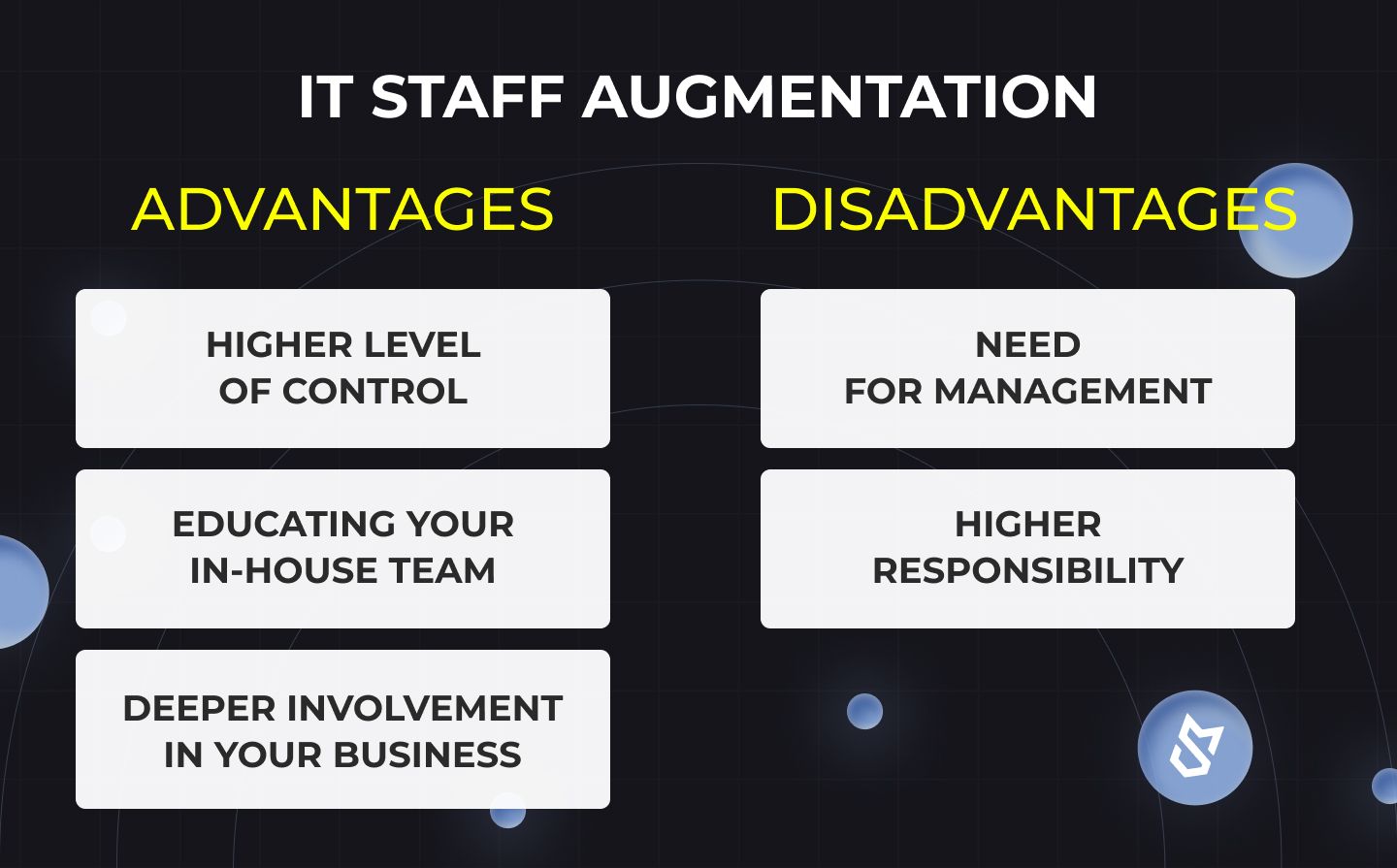
Factors like a bigger pool of talent, higher productivity, and saving costs on talent acquisition and employee retention apply equally to IT staff augmentation and outsourcing. Here, let us highlight some advantages and disadvantages of each model compared to the other specifically.
Advantage of staff augmentation #1: Higher level of control
As mentioned above, with staff augmentation, you bring people aboard your business ship, meaning you’re the captain there. You will have complete control over the processes and the product if you want. Figuratively speaking, you can drop by at any moment and check what everyone is doing, what issues they might have, and what the overall situation with the team building is.
Advantage of staff augmentation #2: Educating your in-house team
When you hire experienced specialists from outside to work closely with your in-house team, you have the opportunity to not only enhance team and project scalability but let your employees learn. New expertise and knowledge sharing will inevitably occur during close communication and collaboration, bringing insights to your employees.
Advantage of staff augmentation #3: Deeper involvement in your business
While augmented employees are but temporary staff, they will still work close with you and your in-house team, meaning they will be involved in your processes and team culture. The cohesion and understanding of your goals will be easier to achieve for augmented employees than for an outsourcing team.
Disadvantage of staff augmentation #1: Need for management
The flip side of higher levels of control is that you will need to exercise that control. An augmented employee will need onboarding and guidance to work efficiently. Unless your company has a project manager or a CTO, this side of cooperation will fall onto you as the business owner or your tech lead. Consequently, the time you or your tech lead would otherwise spend on business-related tasks will be spent on monitoring and helping the new person.
Disadvantage of staff augmentation #2: Higher responsibility
This might sound obvious, but augmented staff is still the staff working for you, so whatever decisions you make regarding the product, the consequences are yours to bear.
Advantages and disadvantages of software outsourcing
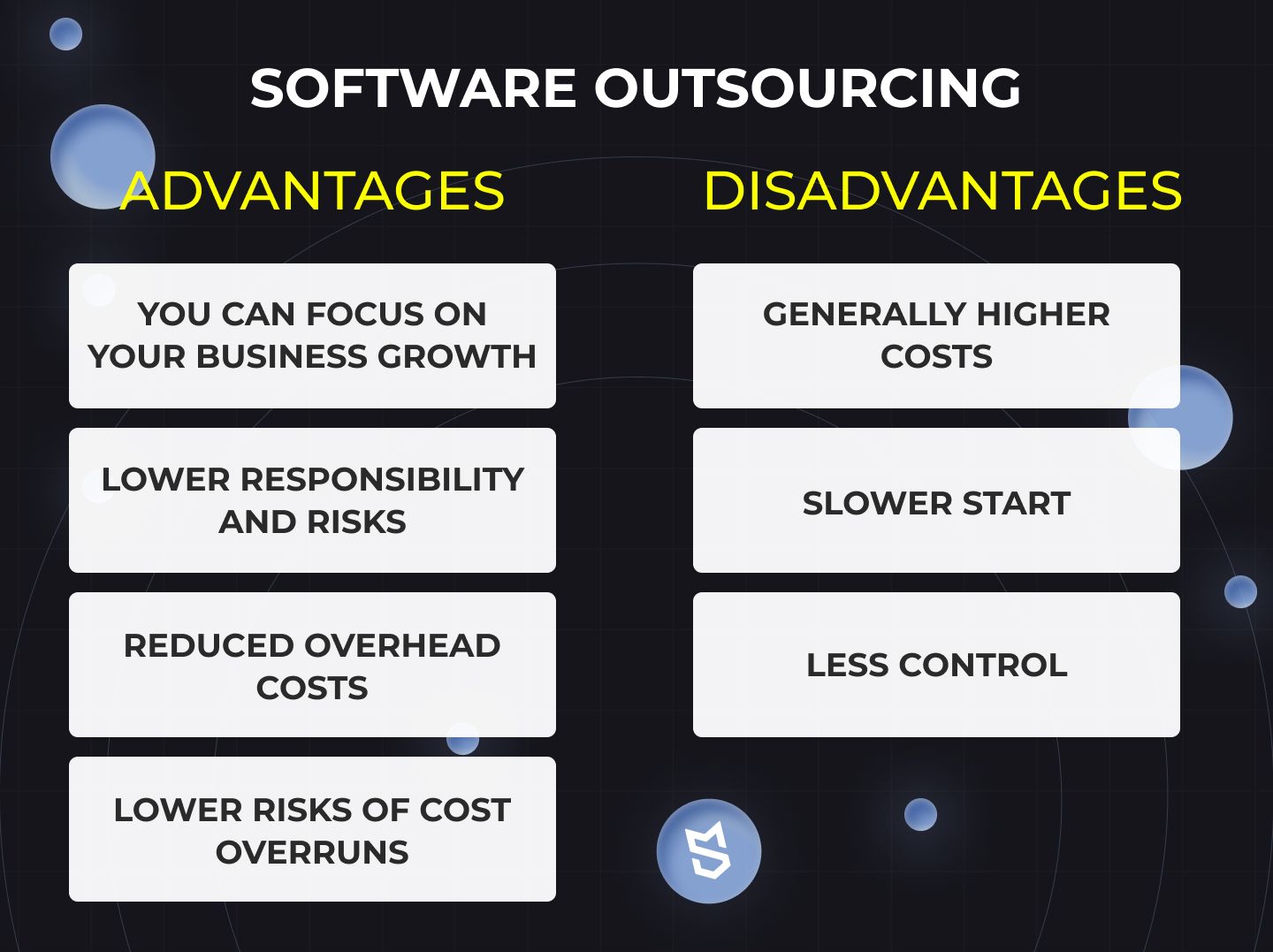
Advantage of outsourcing #1: You can focus more on your business growth
By entrusting your whole product development to a third party team, you free your own time you’d spend on project management and exercising control. When starting to work with an outsourcing team, you set up requirements, acceptance criteria, and deadlines, and your only job is to receive updates at a convenient schedule and to accept the product at the end. Aside from that, you can focus on your business’s other needs, like expanding operations or looking for investors.
Advantage of outsourcing #2: Lower responsibility and risks
As long as your acceptance criteria are defined, all the responsibilities for the product lay on the outsourcing team. They will have to do everything necessary to adhere to the criteria you’ve set. This includes research and implementation of features as well as their testing and whatnot.
Since your responsibilities are lower, the risks you bear are also lower. When working with an outsourcing partner, your agreement will include clauses on risk mitigation, meaning you will be compensated for any delays or issues arising from team mistakes.
Advantage of outsourcing #3: Reduced overhead costs
You will not need to spend time and money on interviewing and onboarding new employees since the vendor is responsible for setting up the team for development. You will also save resources in case issues arise with an employee (sickness, accidents, vacation) — your outsourcing partner will find and replace the employee themselves.
Advantage of outsourcing #4: Lower risks of cost overruns
When working with an outsourcing company under the fixed price model, cost overruns are rare as the project is assessed at the early stages of development. Moreover, your agreement with the partner company may include clauses to manage cost overruns.
Disadvantage of outsourcing #1: Generally higher costs
An outsourced team usually includes some overhead costs to mitigate the responsibilities they carry (for example, replacing an employee or equipment urgently). This makes outsourcing more expensive than staff augmentation in general terms, although cost-efficiency is another issue.
Disadvantage of outsourcing #2: Slower start
In outsourcing, there’s a lot of work to do before the development itself starts. You and your chosen vendor will need to extensively discuss the budget, the requirements and the definition of done, the timeframe for development, etc.
Disadvantage of outsourcing #3: Less control
As we covered above, your control over the development process in outsourcing is limited to pre-scheduled team reports/syncs and acceptance of the product. Who works on the project and how they work, what their performance metrics are — things like these are mostly out of your control.
Staff augmentation vs outsourcing: How to choose
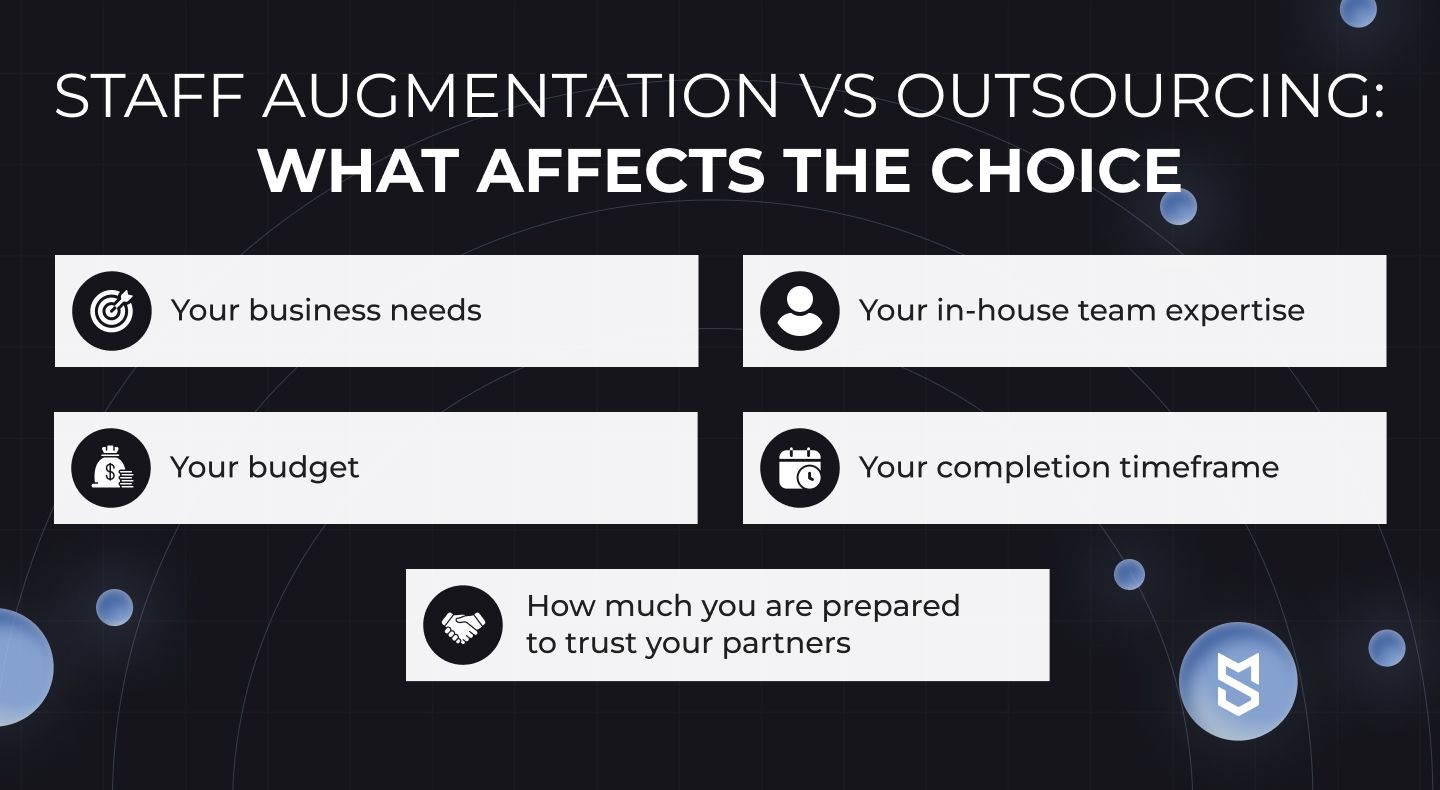
To summarize everything we’ve explained above, let us now outline which factors should affect your choice between outsourcing and staff augmentation.
1. Your business needs
This is the biggest and most important question you need to ask yourself before making a decision: What is it that your business needs, exactly? Is it fast scalability and better resource allocation inside the existing team or is it a product completed to satisfactory levels within a specific timeframe? The former requires staff augmentation, and the latter would probably be more efficient with outsourcing.
Staff augmentation is also a great way to avoid acquiring technical debt (i.e. to fix non-urgent issues before they become urgent).
2. Your in-house team expertise
If you have an in-house team and they’re experienced enough, you won’t need to outsource in most cases. Staff augmentation will be the go-to solution for such cases. Although, there are exceptions.
One of our clients initially partnered with Mind Studios for staff augmentation on a product they were building. As time went by, our collaboration was satisfactory for both sides. At some point, however, this client decided to expand their business and build another product. They moved their in-house team to this new product and switched their partnership with us to entrust us to finish the first product in full.
3. Your budget
Outsourcing is usually more expensive than staff augmentation, in absolute terms. However, the cost of outsourcing is set at the very beginning of work and, if all goes well, rarely overrun. It’s also possible to reduce the cost of outsourcing development, but it usually involves cutting or postponing certain functionality implementation.
Staff augmentation, while cheaper in absolute terms, can go quite high if the product development drags on. Which is why this model is more often used for products of smaller scale.
4. Your completion timeframe
Outsourcing teams are bound by agreements to deliver your product on time, meaning that, unless you decide to implement major changes mid-project, you will get your product before your set date. If the team doesn’t deliver on time, they will have to compensate you.
Staff augmentation, on the other hand, is only as bound as your in-house team is in terms of timeframe. You can fire a temp if they don’t do their job adequately enough, of course, but the completion of the whole product is not the responsibility of augmented employees.
If you need rigid adherence to deadlines in product launch, outsourcing might be the better option. If your project has a floating timeframe or can be postponed or paused for some reason (for example, while you’re looking for investors), staff augmentation is more flexible and easier to handle.
5. How much you are prepared to trust your partners
The issue of control affects the software outsourcing vs IT staff augmentation debate quite heavily. With outsourcing, you need higher trust levels as you basically give away the project to a third party to build. You’re the owner and you’ll have exclusive rights to the source code after the product is built, but you can’t influence how the team works as long as they deliver on time and at proper quality. If you’d rather be your project’s main manager, you might want to choose staff augmentation.
How to do IT team augmentation successfully: 5 tips
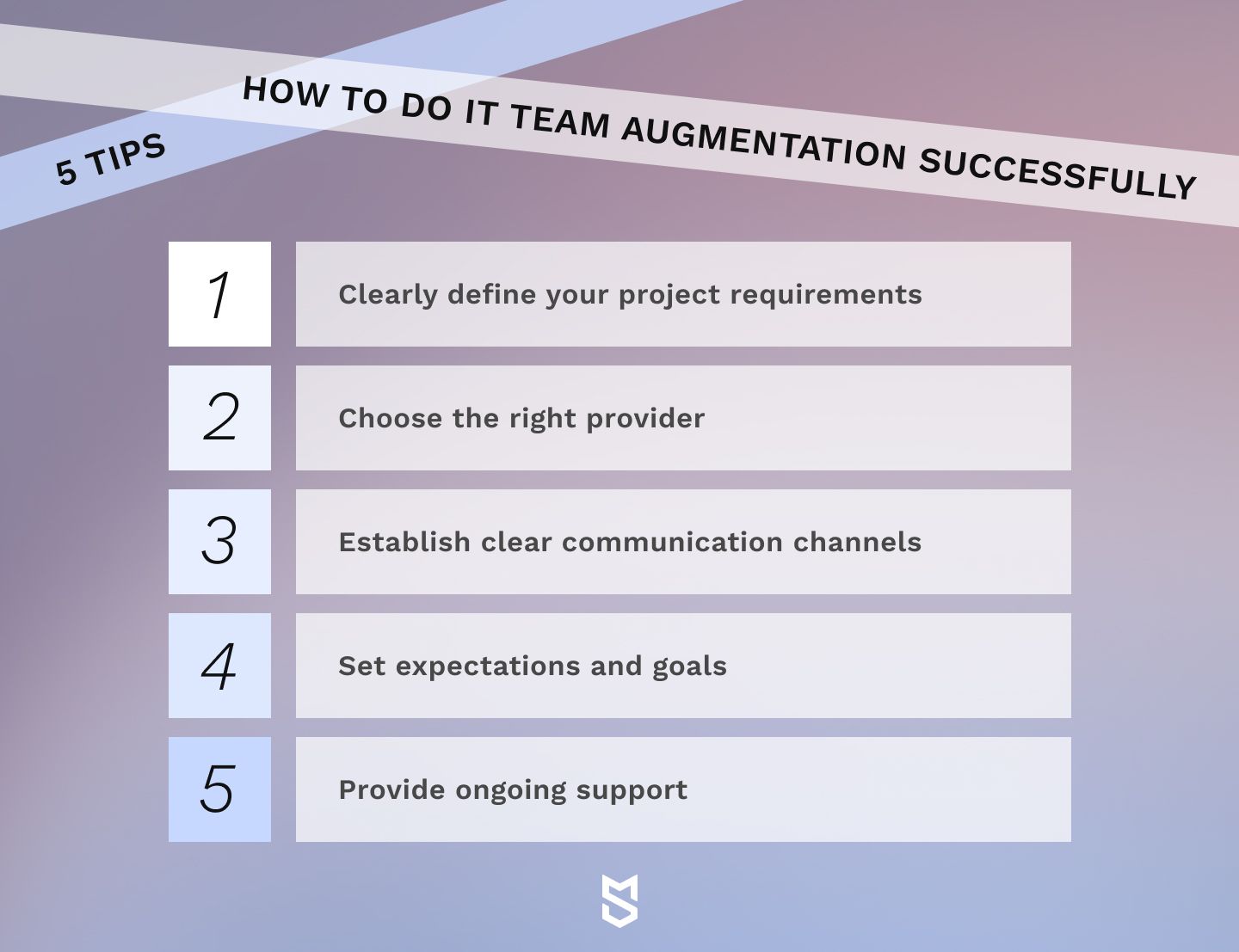
As any hiring, IT staff scaling using temporary external work force can go wrong. To avoid that and save yourself time and money (and a good chunk of mental health), we recommend following several rules.
1. Clearly define your project requirements
The IT staff extension methodology works best with well-defined goals and software requirements. When you know exactly what you need from external temps, you’ll find appropriate people faster.
Discuss with your in-house team exactly what they need to finish your project on time and with all necessary functionality. Do they need commodity temps to complete tasks faster or do the work with lower business information access so that in-house developers could focus on something only they can do? Or do you need a specialist knowledgeable in a certain area?
Set up proper deadlines and outline clear requirements so that when you approach IT staff augmentation consulting companies, they can quickly choose proper staff for you.
2. Choose the right provider
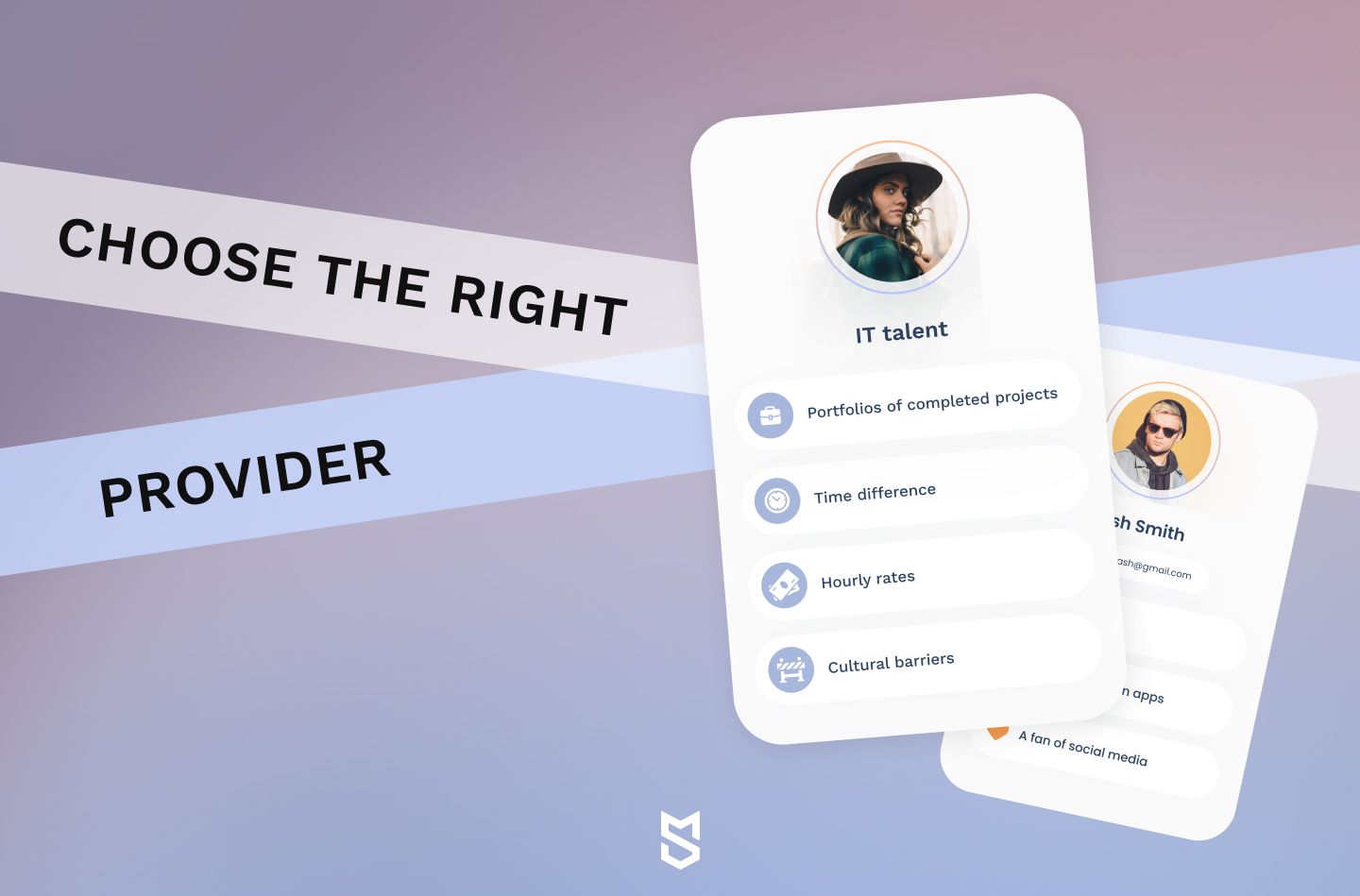
The global market offers an enormous pool of talent, meaning you’ll rarely need to compromise too much. But on the flip side, it means you might sometimes have a hard time choosing.
Here are things we recommend taking into account when choosing IT talent augmentation:
- Portfolios of completed projects. Check and whitelist companies that have experience in your niche or with building functionality you require.
- Hourly rates. If you can afford to spend a lot of money on augmented staff, that’s great. But seeing as one of staff augmentation’s biggest perks is cost-efficiency, keeping in mind your budget will do you good.
- Time difference. Augmented staff will have to collaborate with your in-house team. Depending on how close that collaboration needs to be, you might be limited in options across oceans due to time differences. In some cases of very tight schedules and extremely close interaction between augmented and in-house employees, for example, your only options might be onshore or nearshore staff augmentation. When time difference is of lesser importance, offshore remote IT staff augmentation might be a cheaper and/or more high-quality solution.
- Cultural barriers. Most software development professionals these days speak English at a sufficient level, meaning language barriers are a fairly rare occurrence even if your augmented IT staff is from a country far away. However, it’s important to consider cultural differences as well. Work ethics and processes vary not just on a personal level but also from country to country.
We at Mind Studios have experienced this first-hand when working with clients from China, Middle East, Europe, and the US. You need to find a team that’s adaptable to your in-house team’s mindset, for smoother cooperation.
3. Establish clear communication channels
When you’re working with a remote team — which is the case in most augmented staff situations — managing the collaboration becomes trickier than with an in-house team. More so when it’s not management-team communication like in outsourcing but team-team communication.
If you have internal communication software, you can add augmented staff there, or you can use secure instant messengers and project management software with messaging functionality. The important thing here is to set up everything and establish communication guidelines for temporary employees.
4. Set expectations and goals
On-demand IT staffing is a model where clear goals are of utmost importance, especially if you want to stay within budget. Since you’re working with temporary staff, their understanding of your business intricacies and processes is by default limited, as is their immersion into your business goals.
That’s why you need to specify what your goal is for the augmented team and what you expect of them: the scope of work, the deadlines, the communication style, etc.
5. Provide ongoing support
Honesty and transparency go a long way to ensure quality collaboration. Keep up communication with your augmented staff beyond onboarding to catch any miscommunication or other issues before they escalate to cause financial loss and missed deadlines.
Mind Studios as your tech partner
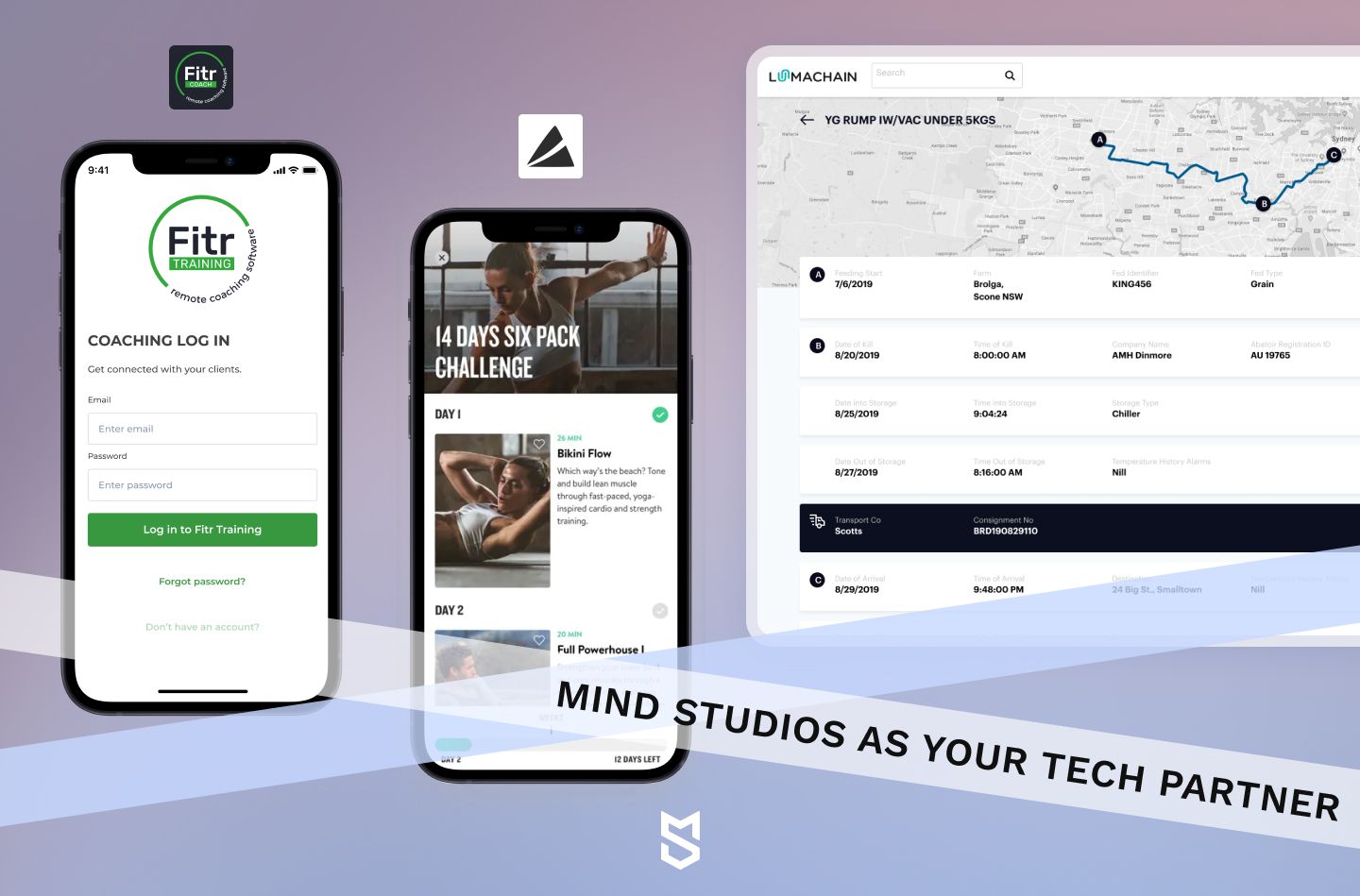
We at Mind Studios have been doing IT staff augmentation for years, although we just recently singled it out into a separate service. For example, Asana Rebel, the famous yoga app, partnered with us several times throughout the years to build new functionality into their Android app; the latest stint took place just last year in 2022.
We’ve also been a part of Lumachain, a product in the meat industry logistics and supply chain.
In Fitr.Training, our developers worked in collaboration with our client’s management and marketing team to deliver a superb product to the fitness market.
One of our ongoing clients started our partnership with us by hiring our specialists to augment their existing team, but later entrusted the whole project to us and moved their in-house team to a new product.
According to our Head of Business Development Anton Baryshevskiy, our clients appreciate Mind Studios as partners because we go above and beyond just bare requested service. Even as commodity staff, our engineers immerse themselves in the project, analyze it, follow its lifecycle, and voice their ideas for improvement. Thanks to this, many of our clients ended up with more successful products. And we’re proud of that.
Conclusion
IT staff augmentation is gaining popularity with small companies and huge corporations alike, and this trend is set to continue into the future. The benefits of hiring temporary project-based staff from specialized agencies are too great to ignore: from cost saving to flexibility and upskilling, the pros outweigh the possible cons quite nicely. So now is exactly the time to hop on and help your business grow faster with less investment.
Mind Studios values quality communication and speedy delivery of high-end products at moderate IT staff augmentation cost. If you’re looking for specialists to enhance your in-house development team, feel free to leave us a message in the contact form; our business development specialists will reach out to you with a free 45-minute consultation so that you can check if we match with your team for partnership.

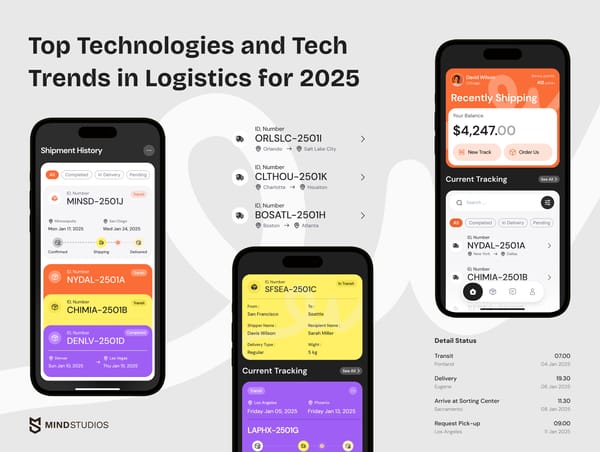

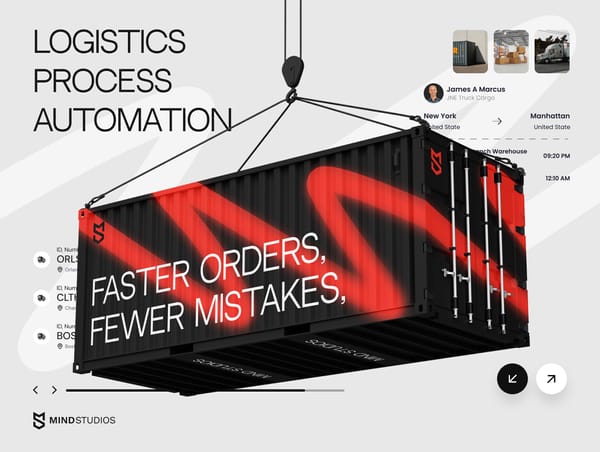
![How to Create an On-Demand Medicine Delivery App [Expert Guide]](https://themindstudios.com/blog/content/images/size/w600/2025/03/IMG-1-Cover-6.jpg)



